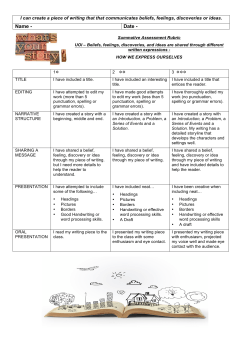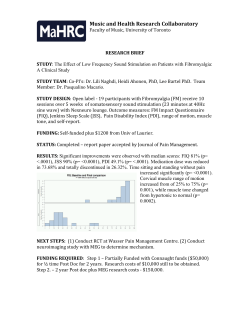
Dean`s Office â Administration and Financial Affairs
Purpose 0 To determine if a widely used assessment of visual motor skills, the Test of Visual Motor Integration (VMI), is appropriate for use as an outcome measure for handwriting interventions. Background 0 The Beery-Buktenika Developmental Test of Visual Motor Integration (VMI) is often used to determine eligibility for OT services and also has been used as an outcome measure to determine improvements in visual-motor integration skills following handwriting interventions (Howe et al., 2013). 0 Purpose of the tool is to identify children who have difficulty in the area of visual-motor integration, so proper treatment can be provided (Beery & Beery, 2010). Background 0 Research consistently demonstrates moderate correlations between visual motor integration as measured by the VMI and handwriting (Barnhardt, et al., 2005; Brossard-Racine, et al., 2011; Cornhill & Case-Smith, 1996; Daly, et al., 2003; Parush, et al., 2010; Volman, et al., 2006; Weintraub & Graham, 2000) 0 “Correlational studies reflect an association between visual-motor integration and handwriting, as expected considering the nature of the task, and do not imply causation” (Goyen & Duff, 2004, p. 111). 1 Background Design 0 Although research has identified that the VMI is a potential predictor of handwriting legibility (Brossard-Racine, et al., 2011; Cornhill & Case-Smith, 1996), recent research suggests that it is not an effective outcome measure for handwriting interventions (Howe et al., 2013; McGarrigle & Nelson, 2006; Poon et al., 2010) 0 Therefore, the purpose of this study is to provide more definitive information on whether a widely used assessment of visual motor skills, the VMI, is appropriate for use as an outcome measure for handwriting interventions. • • Part of a larger study designed to investigate the effect of a popular handwriting program (SMHP) implemented integrated in the classroom curriculum Two-group pre-test post-test design was implemented at 2 separate schools in 2 separate states • • Randomized classrooms to the intervention and standard classroom instruction for one site Other site used a convenience assignment due to teacher availability and other administrative factors Participants: Demographic Characteristics at Baseline Kindergarteners 1 1st Graders 1 2nd Graders 1 Procedures Whole Sample 1 N % N % N % N % New York 23 41.8 32 43.2 38 48.7 93 44.9 Massachusetts 32 58.2 42 56.8 40 51.3 114 55.1 5 45 81.8 0 0.0 0 0.0 45 21.7 6 10 18.2 61 82.4 0 0.0 71 34.3 7 0 0.0 12 16.2 59 75.6 71 34.3 8 0 0.0 1 1.4 19 24.4 20 9.7 Male 23 41.8 31 41.9 33 42.3 87 42.0 Female 32 58.2 43 58.1 45 57.7 120 58.0 Right Handed 48 87.3 66 89.2 74 94.9 188 90.8 Left Handed Site Age 0 IRB and permission obtained from schools and parents 0 Teachers provided with fidelity manuals for intervention and 0 Gender 0 Hand Orientation 7 12.7 8 10.8 4 5.1 19 9.2 With IEP 2 2 3.6 3 4.1 4 5.1 9 4.4 Have a Diagnosis 1 1.8 7 9.5 10 12.8 18 8.7 Receiving OT 3 2 3.6 8 10.8 9 11.5 19 9.2 0 0 training provided on implementation of the Size Matters Handwriting Program (SMHP) Experimental group received 40 twenty minute intervention sessions using the SMHP over a period of 12 weeks while control group participated in standard handwriting instruction Outcome measures of Test of Handwriting Skills – Revised (THSR), Minnesota Handwriting Assessment (MHA), VMI were collected at pre-test and post-test and administered in group formats Scoring Data Analysis 2 Results: Comparing Changes Over Time on Handwriting Measures for Control and Experimental Groups Change Over Time (Post – Pre) Experimental Control Mean SD N Mean N Independent Samples T-Tests Comparing Change Over Time Across Groups Adj. PValue † Results: Group Differences in Standardized VMI Scores Pre- and Post-Intervention and Changes Over Time |d| ‡ SD t DF P-Val THS – Airplane 27 6.6 3.2* 28 1.5 3.0 6.0 52.6 <.0001 0.0000 1.6 THS – Butterfly 27 7.2 2.3* 28 1.5 2.8 8.2 51.7 <.0001 0.0000 2.2 Control THS – Tree 27 6.7 5.2* 28 2.4 4.3 3.4 50.4 0.0013 0.0388 0.9 MHA – Rate 39 -6.2 6.8* 35 -0.5 5.6 -4.0 71.4 0.0002 0.0051 0.9 MHA – Legibility 39 1.3 3.6 35 -0.3 1.8 2.5 56.3 0.0143 0.4274 0.6 Experimental T-Test N Mean SD N Mean SD Kindergarten Kindergarten T-Stat DF P-Value PreIntervention Standardized VMI Scores 1st Grade MHA – Form 39 3.8 4.9* 35 1.3 4.3 2.3 72.0 0.0249 0.7486 0.5 MHA – Alignment 39 7.3 7.1* 35 1.2 4.3 4.6 63.3 <.0001 0.0007 1.1 MHA – Size 39 10.7 7.6* 35 1.3 4.6 6.5 63.4 <.0001 0.0000 1.5 MHA – Spacing 39 0.6 4.6 35 -0.3 2.7 1.1 62.6 0.2979 1.0000 0.2 THS – Bus 39 4.3 3.3* 35 2.1 2.7* 3.3 71.2 0.0017 0.0514 0.8 THS – Frog 39 4.1 2.9* 35 2.0 2.3* 3.6 70.0 0.0007 0.0203 0.8 THS – Horse 39 4.7 4.1* 35 2.4 5.0 2.2 66.4 0.0299 0.8958 0.5 THS – Truck 39 4.9 4.8* 35 2.7 2.7* 2.5 60.9 0.0166 0.5037 0.6 THS – Book 39 29 91.9 10.6 27 94.6 11.8 0.9 52.2 First Grade 36 88.9 9.0 39 88.0 8.7 -0.5 72.1 0.646 Second Grade 40 91.0 11.8 39 91.1 9.1 0.0 72.7 0.9742 0.367 Everyone 105 90.5 10.6 105 90.8 10.0 0.2 207.2 0.8303 0.2183 PostIntervention Standardized VMI Scores 5.1 4.4* 35 3.2 3.7* 2.0 71.6 0.0505 1.0000 0.5 Kindergarten 29 89.7 9.3 27 93.6 13.3 1.3 46.2 THS – Lion 39 6.1 3.5* 35 2.3 4.1 4.3 67.8 <.0001 0.0016 1.0 First Grade 35 88.7 7.2 39 87.4 90.1 -0.7 71.2 0.492 MHA – Rate 38 -0.2 2.9 40 -0.1 3.7 -0.2 73.2 0.8842 1.0000 0.0 Second Grade 40 87.8 10.7 37 90.7 7.0 1.4 68.0 0.1562 MHA – Legibility 38 0.6 2.0 40 -0.9 1.9 3.1 75.4 0.0024 0.0725 0.7 Everyone 104 88.6 9.2 103 90.2 10.0 1.2 203.4 0.2373 Kindergarten 2nd Grade MHA – Form 38 MHA – Alignment 2.6 4.5* 40 -0.8 4.6 3.3 76.0 0.0017 0.0519 0.7 38 3.8 5.4* 40 -1.3 3.9 4.8 66.8 <.0001 0.0003 1.1 MHA – Size 38 11.8 8.1* 40 -0.3 7.8 6.7 75.4 <.0001 0.0000 1.5 MHA – Spacing 38 0.4 2.9 40 -0.9 4.2 1.6 68.7 0.1245 1.0000 0.4 THS – Airplane 38 3.4 3.2* 40 0.3 2.2 4.9 65.3 <.0001 0.0002 1.1 THS – Bus 38 2.5 3.3* 40 -1.1 2.5 5.4 67.8 <.0001 0.0000 1.2 THS – Butterfly 38 3.6 THS – Frog 2.8* 40 -0.7 2.9 6.7 76.0 <.0001 0.0000 1.5 38 1.5 3.1 40 -1.2 2.7 3.9 73.3 0.0002 0.0061 0.9 THS – Tree 38 2.6 3.3* 40 -0.9 3.3 4.7 75.8 <.0001 0.0003 1.1 THS – Horse 38 3.1 4.2* 40 -0.9 4.3 4.1 75.9 <.0001 0.0029 0.9 THS – Truck 38 1.5 3.0 40 -1.2 2.9 4.0 75.1 0.0002 0.0053 0.9 THS – Book 38 1.6 3.3 40 -1.7 2.5* 5.0 68.1 <.0001 0.0002 1.1 THS – Lion 38 2.8 2.6* 40 -1.2 3.1 6.1 74.9 <.0001 0.0000 1.4 Results: Pearson Correlations Between Pre-Intervention Standardized VMI Scores and Handwriting Measures Standardized VM I Scores Kindergarten Raw Rho P-Value 0.27 0.0456 0.25 0.0635 0.38 0.0038 First Grade Raw Rho P-Value Second Grade Raw Bus Butterfly 0.31 Frog Tree 0.35 0.0075 0.0022 29 -2.2 7.9 27 -1.1 7.1 0.6 54.0 0.5752 First Grade 35 -0.3 8.0 39 -0.5 8.7 -0.1 72.0 0.9081 Second Grade 40 -3.2 9.6 37 -0.4 6.7 1.5 69.9 0.131 Everyone 104 -2.0 8.7 103 -0.6 7.6 1.2 202.0 0.2339 Discussion Overall Raw Rho P-Value Rho P-Value 0.25 0.0286 0.16 0.0627 0.38 0.0005 0.37 <.0001 0.32 0.0037 0.16 0.0585 0.35 0.0015 0.37 <.0001 0.26 0.0212 0.21 0.0144 THS (Standardized) Airplane Changes in Standardized VMI Scores (Post-Pre) 1 Horse 0.35 0.002 0.21 0.0634 0.29 0.0003 Truck 0.35 0.002 0.21 0.0609 0.30 0.0002 Book 0.38 0.0007 0.16 0.1519 0.29 0.0003 Lion 0.19 0.0938 0.33 0.0031 0.29 0.0003 Minnesota Handwriting Assessment Rate 0.08 0.4919 -0.01 0.9423 0.05 0.5139 Legibility 0.33 0.0035 0.4 0.0003 0.33 <.0001 Form 0.46 <.0001 0.39 0.0004 0.41 <.0001 Alignment 0.23 0.0485 0.33 0.0032 0.28 0.0003 Size 0.35 0.0021 0.2 0.0713 0.23 0.0036 Spacing 0.24 0.0385 0.43 <.0001 0.34 <.0001 0 The results of this study did not support the use of the VMI as an outcome measure for assessing changes following a handwriting intervention. 0 Consistent with other research (Howe et al., 2013; McGarrigle & Nelson, 2006; Poon et al., 2010) 0 VMI was not sensitive enough to measure changes in handwriting following occupational therapy interventions 0 If the VMI was the only posttest measure used in this study to examine the outcomes of the intervention, results would have suggested that the children had not demonstrated progress, although handwriting measures including the THS-R and MHA demonstrated significant handwriting improvements. 0 It is important to ensure that our measurement tools are appropriate for, and sensitive to, the construct being measured, which in turn, must be the construct for which the intervention is addressing. 3 Discussion 0 Although we know that visual motor integration is consistently correlated with handwriting, the VMI was never intended to assess handwriting ability, nor designed to screen specifically for handwriting dysfunction (Chang and Yu, 2009; Goyen and Duff, 2005). 0 The literature consistently supports some level of correlation between VMI scores and handwriting lending some support to the continued use of the VMI as a tool to measure the component skills of visual motor integration, and to help determine which children could benefit from further assessment and treatment. 0 The correlations in this review were small to moderate, suggesting that additional forms of assessment are necessary, including handwriting, fine motor, and environmental assessments, as well as clinical observations, when making determinations regarding treatment and progress. References References and Contacts 0 Information for this presentation was obtained from: Pfeiffer, B., Moskowitz, B., Paoletti, A., Brusilovskiy, E., Zylstra, S. E., & Murray, T. (In press). Test of Visual Motor Integration (VMI): An Effective Outcome Measure for Handwriting Interventions for Kindergarten, First-Grade, and Second-Grade Students? American Journal of Occupational Therapy. 0 Contact Information Beth Pfeiffer, PhD., OTR/L, BCP bpfeiffe@temple.edu Beverly Moskowitz, DOT, MS, OTR/L bevm1116@gmail.com Sheryl Eckberg Zylstra sherylzyl@aol.com References 0 Barnhardt, C., Borsting, E., Deland, P., Pham, N., & Vu, T. (2005). Relationship between visual-motor integration and spatial organization of written language and math. Optometry and Vision Science, 82(2), E138-E143. doi: 1040-5488/05/8202-0138/0 0 Beery, K.E., & Beery N.A. (2010). The Beery-Buktenica developmental test of visual-motor 0 0 0 0 0 integration: Administration, scoring, and teaching manual, 6th ed., Minneapolis Minnesota: Pearson, Inc. Brossard-Racine, M., Majnemer, A., Shevell, M., Snider, L., & Bélanger, S. A. (2011). Handwriting capacity in children newly diagnosed with attention deficit hyperactivity disorder. Research in Developmental Disabilities, 32(6), 2927-2934. doi: 10.1016/j.ridd.2011.05.010 Cornhill, H., & Case-Smith, J. (1996). Factors that relate to good and poor handwriting. American Journal of Occupational Therapy, 50(9), 732-739. Chang, S.H., & Yu, N.Y. (2009) Discriminant validity of the visual motor integration test in screening children with handwriting dysfunction. Perceptual and Motor Skills, 109(3), 770-782. doi: 10.2466/PMS.109.3.770-787 Daly, C. J., & Kelley, G.T., Krauss, A. (2003). Relationship between visual-motor integration and handwriting skills of children in kindergarten: A modified replication study. American Journal of Occupational Therapy, 57(4), 459-462. Goyen, T., & Duff, S. (2005). Discriminant validity of the developmental test of visual-motor integration in relation to children with handwriting dysfunction. Australian Occupational Therapy Journal, 52(2), 109-115. doi: 10.1111/j.1440-1630.2005.00488.x 0 Howe, T., Roston, K. L., Sheu, C., & Hinojosa, J. (2013). Assessing handwriting intervention effectiveness in elementary school students: A two-group controlled study. American Journal of Occupational Therapy, 67(1), 19-25. doi: 10.5014/ajot.2013.005470 0 McGarrigle, J., & Nelson, A. (2006). Evaluating a school skills programme for Australian indigenous children: A pilot study. Occupational Therapy International, 13(1), 1-20. doi: 10.1002/oti.10 0 Parush, S., Lifshitz, N., Yochman, A., & Weintraub, N. (2010). Relationships between handwriting components and underlying perceptual-motor functions among students during copying and dictation tasks. Occupational Therapy Journal of Research, 30(1), 39-48. doi: 10.3928/1539449220091214-06 0 Pfeiffer, B., Murray, T., Rai, G, & Brusilovskiy, E. (in press). The effectiveness of the Size Matters Handwriting Program. Occupational Therapy Journal of Research: Occupation, Participation, and Health. 0 Poon, K. W., Li-Tsang, C. W. P., Weiss, T. P. L., & Rosenblum, S. (2010). The effect of a computerized visual perception and visual-motor integration training program on improving Chinese handwriting of children with handwriting difficulties. Research in Developmental Disabilities, 31(6), 1552-1560. doi: 10.1016/j.ridd.2010.06.001 0 Volman, M., van Schendel, B., & Jongmans, M. (2006). Handwriting difficulties in primary school children: A search for underlying mechanisms. American Journal of Occupational Therapy, 60, 451460. 0 Weintraub, N., & Graham, S. (2000). The contribution to gender, orthographic finger function, and visual-motor processes to the prediction of handwriting status. Occupational Therapy Journal of Research, 20(2), 121-140. 4
© Copyright 2025









